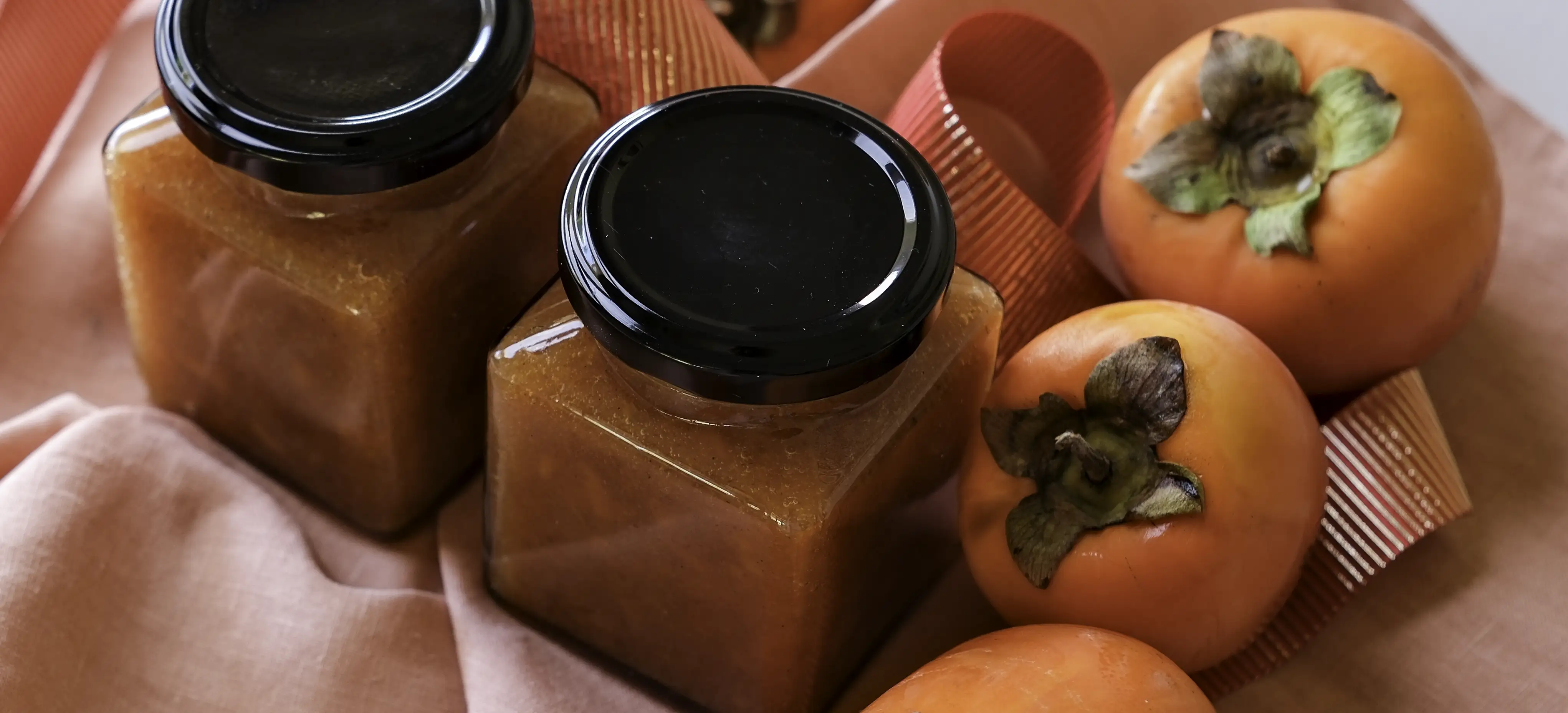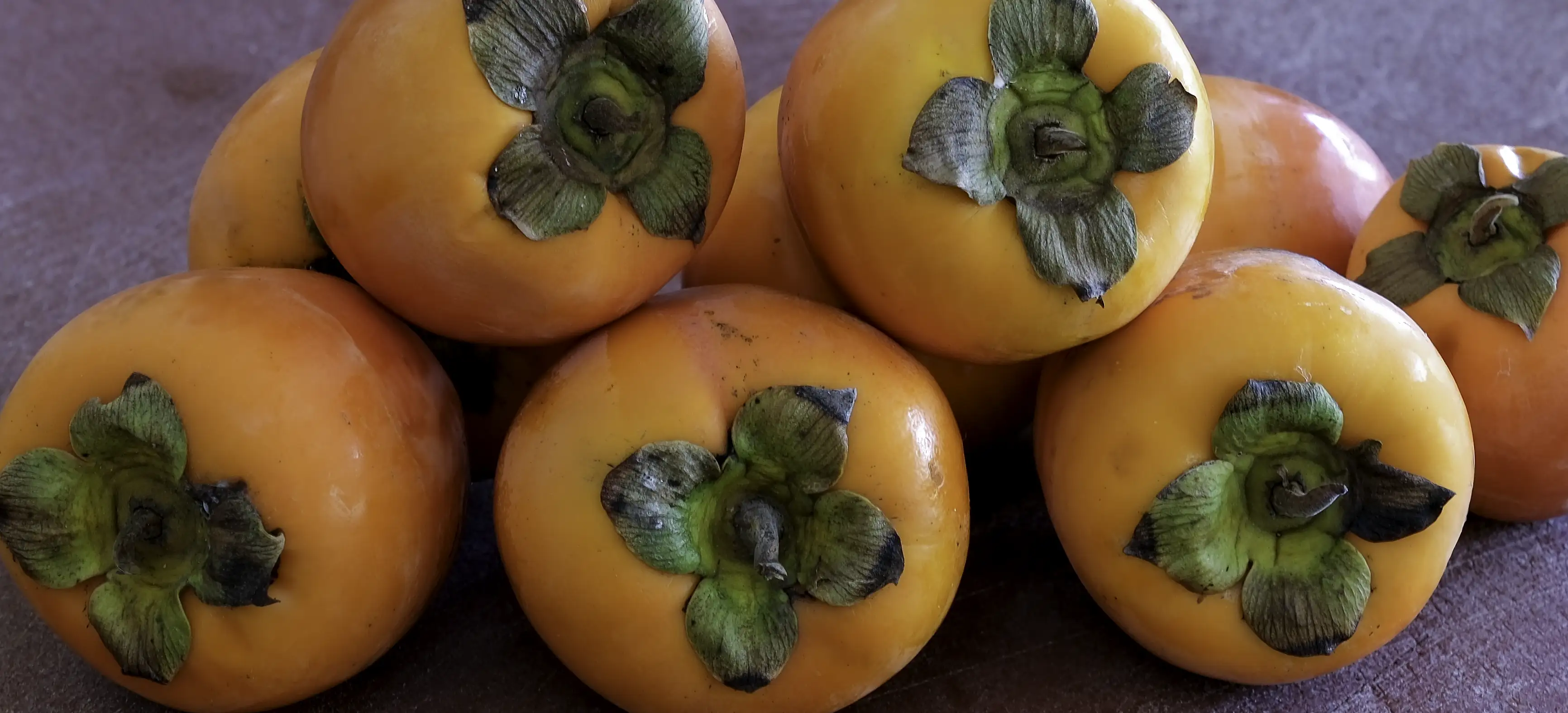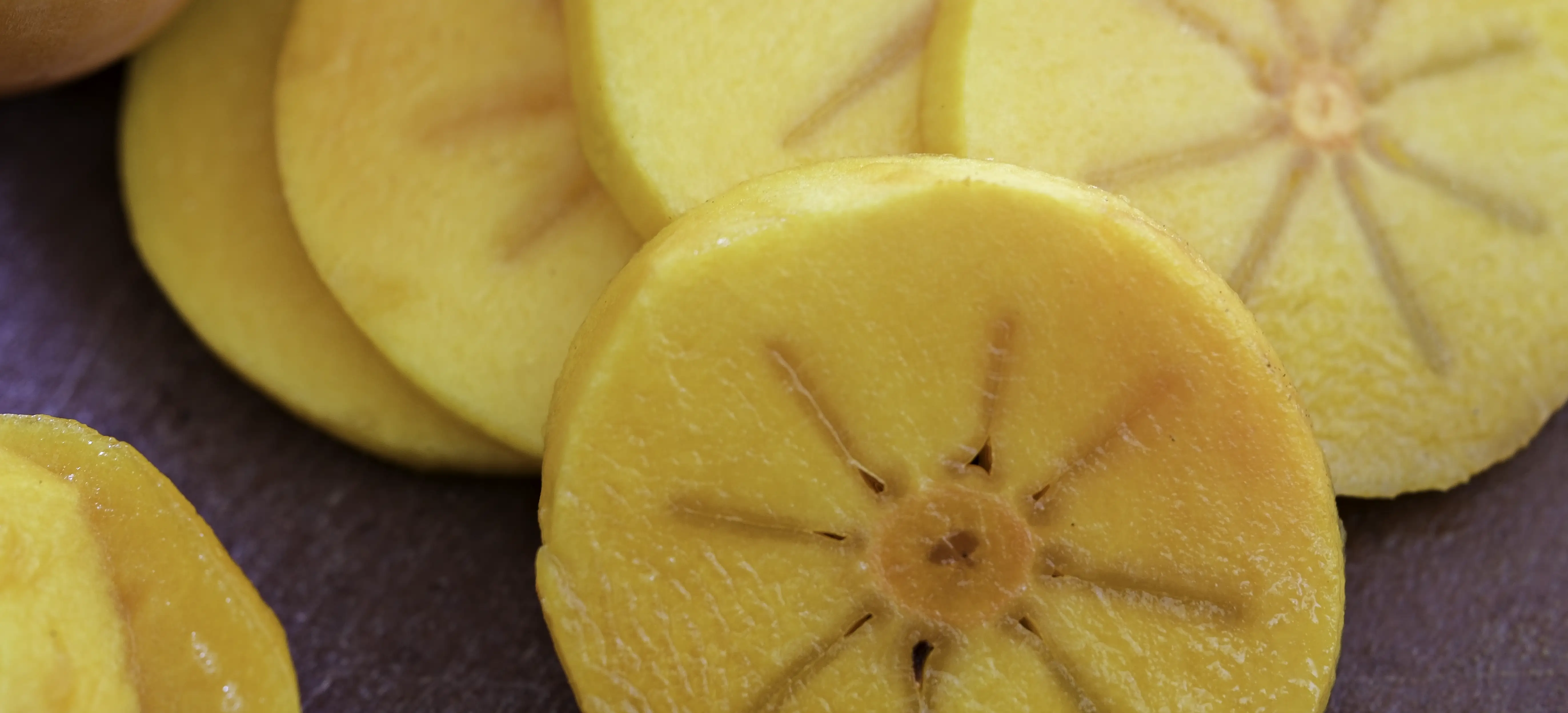Chocolate Persimmon and Cinnamon Jam
- Jams, Jellies & Marmalades

Persimmons may be a bit quirky and looked over by those that haven’t been seduced by their charms yet, but they are delicious eaten ripe or when made into jam. This persimmon jam recipe, with a touch of cinnamon and vanilla, tastes exotic and is very easy to make. Spread it on your favourite breakfast bread, serve on pancakes or waffles with ice cream or spooned over yoghurt, cereal or a favourite pudding for something different. It makes a special homemade thank you gift for foodie friends, family members or for the curious who enjoy tasting new culinary delights.
Big thanks to a special friend who shared her bounty of rare Japanese Chocolate persimmons. These are not commercially available, but Fuyu persimmons are a perfect substitute.
- Preparation Time:
- 40 minutes
- Cooking Time:
- 45 minutes
- Quantity:
- 4 x 250 ml jars
PREPARATION
Sterilise glass jars and lids that have a protective lining. Have the jars and lids dry, hot, and ready for the bottling stage. Refer to my article How to Sterilise Jars and Bottles for a range of easy sterilising methods.
Warm the sugar. Refer Notes Section below: How To Warm Sugar, for more information if required.

INGREDIENTS
- 600g
- Persimmon, prepared
- To cover fruit
- Water
- 1/2
- Cinnamon quill
- 1/2 teaspoon
- Vanilla Paste
- 30 ml
- Lemon juice, fresh
- 470g
- Sugar, white
METHOD
Gently wash and dry the persimmons to remove any garden or shop dust or debris.
To prepare the persimmons, remove the bottom and insert a sharp knife into the crown end (calyx), circle it and remove. Peel, cut into quarters, remove the seeds then dice into 1 cm cubes. Discard the seeds and ends.
Place in a stainless-steel preserving pan or a heavy bottom stainless steel pot. Add just enough water to cover the fruit. Place the cinnamon quill in a spice bag. Refer to the Notes Section below: How to Make a Spice Bag, if required. Alternatively add ground cinnamon, to taste, directly into the fruit and water mixture.
Place on the heat, bring to the boil then simmer until the persimmons are soft. Remove the cinnamon quill, if using, and discard.
Add lemon juice, vanilla paste and warmed sugar stirring occasionally to ensure the sugar is dissolved. Then boil rapidly until the setting point is reached. While the jam is boiling, use a sharp-edged spoon or ladle to remove any scum that builds up around the edge of the pot. The jam will take on a paste-like consistency and may bubble and spit in a volcanic manner until it sets. Stir occasionally to ensure it does not burn on the bottom of the pan. Refer to the Notes Section below: Removing the Scum for more information if required.
Using a wide-necked funnel, ladle into the sterilised hot dry jars to within 2.5 cm (1 inch) from the top, distributing the fruit evenly between the jars.
Seal immediately with hot dry lids. The HHH method of HOT dry jars, HOT dry lids and HOT jam creates a vacuum seal as it cools. The “popping” sound, often heard in the kitchen when this method is used, signals a successfully vacuum sealed jar.
If there are no lids, seal with paraffin wax while the jam is hot. Cover with cellulose or plastic film and secure with a rubber band or kitchen twine. Refer to the Notes Section below: Sealing with Paraffin Wax below for more detailed instructions. Note this method does not provide a safe long term storage solution. Alternatively allow the jam to completely cool and seal with a screw top lid.
The HHH method of sealing is preferred as there is reduced risk of contamination prior to sealing.
Once the jars have cooled, wipe down to remove any spillage and label. Store in a cool dark place in the kitchen or pantry
Allow the jam to mature for at least 2 weeks before eating.
Store in the fridge after opening.
NOTES

- Choose ripe but not over ripe or mushy fruit and never use mouldy produce as this produces a poor-quality jam. Remove any damaged or bruised fruit.
- Fresh from the garden, a farmers’ market or from a pick-your-own orchard fruit will provide a more flavourful and aromatic jam.
- If you do not have a preserving pan, use a large heavy bottom pot, preferably stainless steel.
- This will distribute the heat evenly across the pot and the jam while it is cooking. Ensure there is enough space available in the pot for the mixture to double in size while it is rapidly boiling.
- To Warm Sugar
- Put the recipe quantity in an oven proof container and place in a preheated 150 degrees C oven for approximately 10 minutes. The sugar should be warm throughout the bowl.
- Once added to the hot fruit mix, ensure the sugar has completely dissolved before boiling, otherwise the sugar may crystallise later in the jar.
- Warmed sugar dissolves quickly and then a rapid boil, until the setting point is reached, helps to preserve the fresh fruit flavour. Long slow simmering affects the colour and reduces its flavour.
- Good quality jars should be used in all preserving, particularly when they are processed in a hot water bath. Thin jars often cannot withstand the temperatures and may crack either in the bath or on and or after removal. Avoid the disappointment and invest in some good jars from a homewares or preserves outlet.
- Cooking times are an approximation only. They are provided as guidelines as cooking times are influenced by the type of pot and its diameter and height, speed of cooking and fruit ripeness, size, and moisture level.
- Removing the Scum
- Jams, jellies, and marmalades can produce a scum while they are boiling. Impurities from the fruit and sugar will rise to the surface and a fine frothy foam will move towards the edge of the preserving pan.
- Some fruit will produce more scum than others. This is a natural self-clarification process and makes the task of making a high-quality preserve easier. Removing the scum increases the preserve’s clarity. This is very important if it is being submitted for competition. Remove the scum before bottling.
- Using a stainless-steel spoon, skim the scum from around the edge of the preserving pan. Be careful to remove just the scum and not the jam. This can be done while the jam is boiling and/or once it has been taken off the heat.
- Do not attempt to remove the scum from the centre of the boiling jam, as there is an elevated risk the jam will splutter and hot jam burns.
- Sealing with Paraffin Wax
- Paraffin wax was traditionally used as a method of sealing preserves in jars that didn’t have lids. Once considered a very economical and handy method to re-use lidless jars, this technique is now regarded as being out-of-date by today’s food preservation standards. The hot wax, poured over the preserve to seal it, shrinks away from the side of the jar as it cools. This shrinkage, creating gaps around the jar, becomes the entry point for bacteria, moulds, and other impurities. Over time mould develops, particularly under the wax seal and isn’t visible until the seal is broken.
- I used this method in my early preserving days and I’m unaware of any health issues that I may have contracted from it. However, as food preservation storage research has developed over the years, to ensure my home-made preserves are safe for my family and friends, I no longer seal my preserves with paraffin wax. My preferred methods of sealing containers, depending on the type of preserve are the HOT, HOT, HOT Method or the Hot Water Bath Method.
- Sealing with wax is not a long-term storage solution. Use within a couple of months. Once opened store in the fridge.
- How To Make a Spice Bag
- To make the cloth spice bag, drape a square of muslin or calico over a basin. Place the spices and/or herbs outlined in the recipe mixture into the cloth
- Gather up the corners and make a bag by tying it up with kitchen string approximately 2 cm above the fruit. Always allow room between the tie point and spice mixture so the water can bubble through the bag easily. This helps to extract as much flavour as possible from the contents.
- Discard the spices, unless otherwise specified in the recipe, once the bag has been removed from the preserving pan. Wash, dry and keep the cloth for the next batch.
- My tea towel draw has a range of different sized cloths that are on hand for my preserving sessions.
- KNOW YOUR SPICES
- Cinnamon (Cinnamomum verum)
- It contains sweet and aromatic flavours. It does not taste sweet, rather it enhances the perception of sweetness in other ingredients. It draws out sweet notes in savoury dishes. Cinnamaldehyde is the main flavour compound and is sensed by the temperature sensors on the tongue, giving cinnamon a warming quality.
- Cinnamon sticks keep their flavours for up to a year. Keep in an airtight container and store in a cool dark place in the pantry or kitchen. The lighter brown, thinner more fragile sticks are higher quality.
- Inner layers of bark are dried in the sun and rolled together by hand to make “quills.”
- Cinnamon and cassis are distinctly different in appearance and flavour profile.
- Persimmons - Did You Know….
- There are two main varieties, astringent (Hachiya) and non-astringent (Fuyu). The astringent variety is just that. They have that unpleasant puckery taste, as they are full of tannin, until they are fully ripened. How to tell – they will be squelchy soft. Their inside flesh will be soft and jelly like and can be eaten with a spoon.
- The non-astringent varieties are quite different and can be eaten while they are still firm, just like an apple. They can also be sliced for salads and added to cake and muffin batters before baking or can be made into preserve - pickled persimmons, persimmon chutney, dried persimmons.
- And then there’s the Chocolate Persimmon, a rare Japanese variety. It’s named because it has a mahogany brown speckling and spots throughout its orange flesh - not because it tastes like chocolate. They are sweet and filled with spice undertones. Chocolate persimmons are highly valued for their unique, sweet flavouring, especially in Japan, and are sought around the world by persimmon aficionados.
- When cut horizontally across the fruit, they will reveal their architectural star pattern. Some persimmon varieties will contain dark seeds. These should be removed before eating.
- Persimmons Australia, the peak fruit growers association, has prepared this informative video on How to Pick Perfect Persimmon Fruit.
- To ripen persimmons, place them in a brown paper bag and keep in a warm dry place.
- Persimmons can be frozen when ripe.
 Fuyu persimmon with star pattern in flesh and no chocolate colouring
Fuyu persimmon with star pattern in flesh and no chocolate colouring
